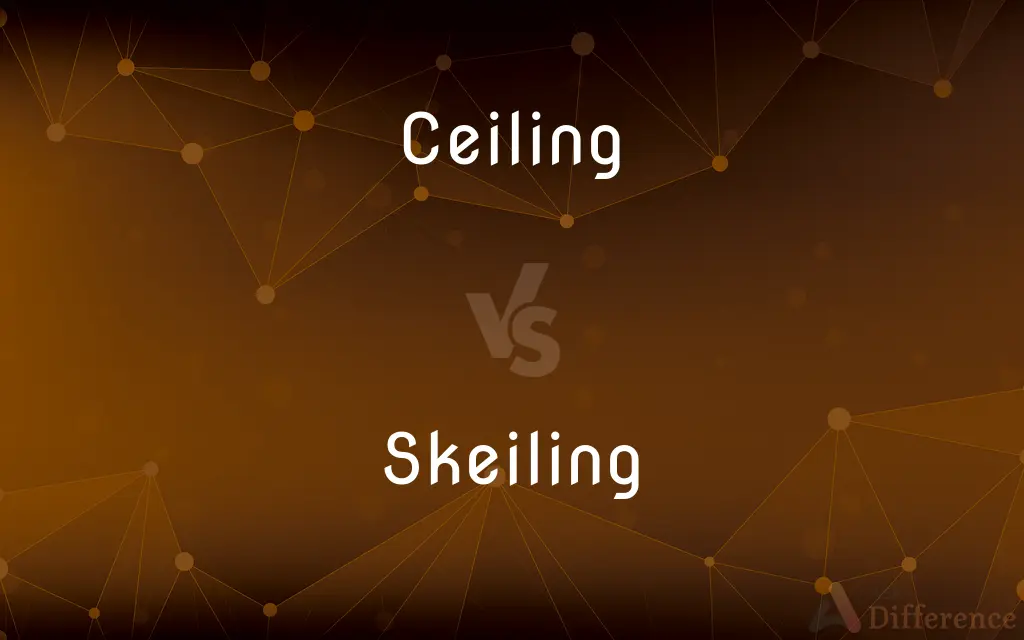Ceiling vs. Skeiling — What's the Difference?
By Tayyaba Rehman — Updated on October 5, 2023
Ceiling refers to the overhead inside surface of a room, while Skeiling is the sloping side of a ceiling, typically found in attics. They differ in position and structure within buildings.

Difference Between Ceiling and Skeiling
Table of Contents
ADVERTISEMENT
Key Differences
Ceiling and Skeiling both relate to architectural structures, providing specific terminology to differentiate between types of overhead interior surfaces within buildings.
A ceiling universally denotes the upper interior surface of a room, separating it from the floor above and providing a barrier to heat, sound, and fire, being a commonplace term in building design.
On the other hand, Skeiling, a term less commonly recognized, refers specifically to the sloping surface between the wall and ceiling in rooms directly beneath a roof, particularly those with a pitched design.
Despite both being parts of building interiors, a ceiling is traditionally flat, horizontal, and spans across the entirety of a room, playing a pivotal role in both aesthetic and functional aspects of architectural design.
Conversely, a skeiling, with its inclined structure, impacts the spatial dynamics of a room, influencing not only its aesthetic appeal but also its utility, often providing a unique, cozy, or restricted space beneath pitched roofs.
ADVERTISEMENT
Comparison Chart
Meaning
Overhead interior surface of a room
Sloping side of a ceiling under a pitched roof
Position
Typically horizontal
Angled or sloped
Universality
Common in all types of buildings
Usually found in attic spaces or under pitched roofs
Utility
Can house lights, fans, etc.
May restrict placement of tall furniture
Structural Impact
Defines room height
Can limit space and affect room’s spatial dynamics
Compare with Definitions
Ceiling
A ceiling is an overhead interior surface that covers the upper limits of a room. It is not generally considered a structural element, but a finished surface concealing the underside of the roof structure or the floor of a story above.
Skeiling
(architecture) A straight sloped part of a ceiling, such as on the underside of a pitched roof.
Ceiling
The upper interior surface of a room or other similar compartment
The books were stacked from floor to ceiling
Ceiling
The inside planking of a ship's bottom and sides.
Ceiling
The upper interior surface of a room.
Ceiling
Material used to cover this surface.
Ceiling
Something resembling a ceiling
A ceiling of leaves over the arbor.
Ceiling
An upper limit, especially as set by regulation
Wage and price ceilings.
Ceiling
The highest altitude under particular weather conditions from which the ground is still visible.
Ceiling
The altitude of the lowest layer of clouds.
Ceiling
The maximum altitude that an aircraft can reach under a given set of conditions, such as a minimum rate of climb.
Ceiling
(Nautical) The planking applied to the interior framework of a ship.
Ceiling
The overhead closure of a room.
The dining room had an ornate ceiling.
Ceiling
The upper limit of an object or action.
Ceiling
(aviation) The highest altitude at which an aircraft can safely maintain flight.
Ceiling
(meteorology) The measurement of visible distance from ground or sea level to an overcast cloud cover; under a clear sky, the ceiling measurement is identified as "unlimited."
Even though it was cloudy, there was still enough ceiling for the Blue Angels to perform a great show.
Ceiling
(mathematics) The smallest integer greater than or equal to a given number.
The ceiling of 4.5 is 5; the ceiling of −4.5 is −4.
Ceiling
(nautical) The inner planking of a vessel.
Ceiling
(finance) The maximum permitted level in a financial transaction.
Ceiling
(architecture) The overhead interior surface that covers the upper limits of a room.
Ceiling
The inside lining of a room overhead; the under side of the floor above; the upper surface opposite to the floor.
Ceiling
The inner planking of a vessel.
Ceiling
The overhead upper surface of a room;
He hated painting the ceiling
Ceiling
(meteorology) altitude of the lowest layer of clouds
Ceiling
An upper limit on what is allowed;
They established a cap for prices
Ceiling
Maximum altitude at which a plane can fly (under specified conditions)
Common Curiosities
Does every room have a ceiling?
Yes, ceilings are standard in architectural design for interior spaces.
Can ceilings have different finishes?
Yes, ceilings can have various finishes like paint, plaster, or tiles.
Is it possible to raise a ceiling?
Yes, raising a ceiling is possible but can be complex and costly.
Can you insulate a skeiling?
Yes, skeilings can be insulated to improve thermal efficiency.
Can ceilings be soundproofed?
Yes, ceilings can be soundproofed using various materials and techniques.
Is a skeiling found in all houses?
No, skeilings are specific to rooms under pitched roofs, like attics.
Is a skeiling always sloped?
Yes, skeilings are typically sloped, following the line of a pitched roof.
Can a ceiling be removed?
Ceilings can be removed or altered, but it involves significant structural work.
What’s the purpose of a skeiling?
A skeiling is often a structural consequence of a pitched roof design.
Are ceilings always flat?
While common, ceilings can also be coffered, vaulted, or have other designs.
Can a skeiling be flattened?
Flattening a skeiling may require altering the roof structure and is often impractical.
Can a ceiling be decorative?
Yes, ceilings can have decorative elements like moldings or intricate designs.
Are skeilings common in modern architecture?
Skeilings are found in modern architecture, often in homes with pitched roofs.
Can skeilings affect room temperature?
Yes, skeilings can influence thermal dynamics due to their proximity to the roof.
What materials are ceilings made of?
Ceilings can be made from plasterboard, wood, metal, or other materials.
Share Your Discovery

Previous Comparison
Wither vs. Whither
Next Comparison
Voucher vs. CouponAuthor Spotlight
Written by
Tayyaba RehmanTayyaba Rehman is a distinguished writer, currently serving as a primary contributor to askdifference.com. As a researcher in semantics and etymology, Tayyaba's passion for the complexity of languages and their distinctions has found a perfect home on the platform. Tayyaba delves into the intricacies of language, distinguishing between commonly confused words and phrases, thereby providing clarity for readers worldwide.













































